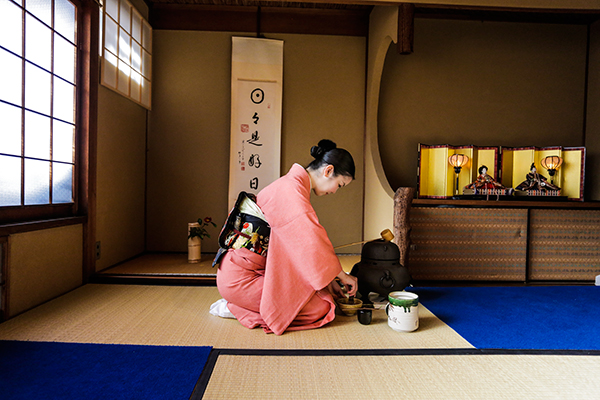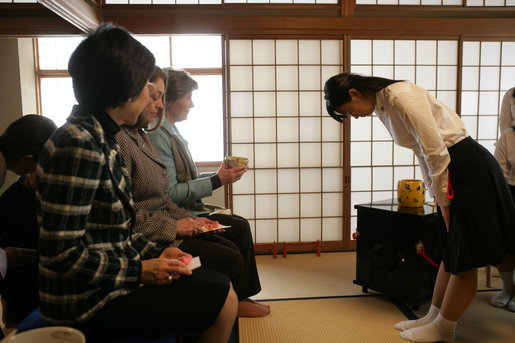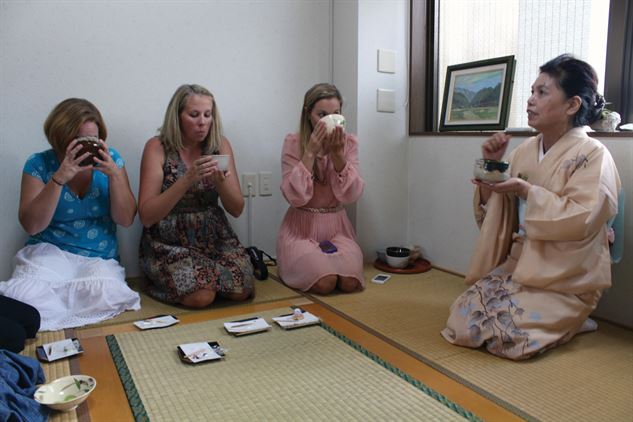The traditional Japanese Tea Ceremony (茶道, sadō or chadō, lit. “the way of tea” or 茶の湯, chanoyu. “hot-water tea”) has its history rooted in the principles of Zen Buddhism.
It is an aesthetic way of welcoming guests. During this welcoming ritual – everything must be done according to an established order.
It has lost its place in common society in current times but it is still a curiosity, for some, a hobby for others and a celebrated part of traditional Japanese culture.
In this article – we will share some key details about Japanese tea ceremonies so that you can learn about them if you are going to observe one while you are studying Japanese with us in Tokyo.

Historic Background of the Japanese Tea Ceremony
Tea was introduced to Japan in the early 8th century from China where a Chinese Buddhist priest wrote a book on the proper method of preparing tea. It is believed that today’s style of tea ceremony preparation was influenced by the book.
Priests and noblemen in Japan consumed tea as a medicine during the Nara period (Japan 710 – 794). During the 12th-century CE, a monk named Eisai introduced a specific way of preparing tea as well as the usage of powdered green tea as a main ingredient.
After returning from a trip to China, he introduced a new technique of preparing the drink by placing powdered green tea, (matcha), into a bowl, then adding hot water and mixing both ingredients together. Through this method, tea rituals became common among Buddhist monks
It was not until the Muromachi Period (1333 – 1573) that tea gained its popularity among people of all social classes and by the 16th-century CE, drinking tea has become popular in Japan.

When would a person perform a Japanese tea ceremony?
The traditional Japanese tea ceremony is usually performed for a guest or it can be performed as a hobby. The tea ceremony is the task of preparing a drink for a guest that is elevated to an art form with a series of movements performed in a strict manner.

Where can a person perform a Japanese tea ceremony?
The tea ceremony is traditionally held in a tatami room. The ceremony can also take place in a purpose-built chashitsu tea house with tatami flooring.
The entrance for guests is sometimes kept low so that guests who are entering would have to bend over. This would symbolize humility.
Usually, in the tatami room, there would be decorative elements such as tokonoma (an alcove) where a scroll or seasonal flowers are on display.

Who can perform a Japanese tea ceremony?
Usually, the tea master would perform. However, anyone can perform a tea ceremony. It is important to uphold the tea ceremony’s etiquette as it is part of the entire experience.

What objects are needed to perform a Japanese tea ceremony?
The main equipment for a tea ceremony includes chasen (tea whisk), natsume (tea container for matcha), chashaku (tea scoop), tea bowl, sweets container or a plate, and the kettle and brazier.
Each piece of equipment is carefully selected in accordance with the circumstances and its specific place during the ceremony.

Why
One of the main purposes of performing the tea ceremony is for the guests to enjoy the hospitality of the host in an atmosphere away from the fast pace of everyday life. Rather than just serving and receiving tea, it is more of a ceremonial way.

How
Step 1: When the guests arrive at the location, they are led through a garden. This can be a representative location if the ceremonial room is within a house. Then, they wash their hands to cleanse themselves symbolically of the dust from the outside world.
After that, they have to step through a small door, which ensures the guest bow in respect to the ceremony. The door of the room serves as a barrier, helping to create a sense of sanctuary.
Step 2: While kneeling on the cushion, the host cleans his or her tools with graceful movements. Purified water is then boiled in an iron kettle on a stove sunk into the floor.
Step 3: A fukusa (silk cloth), representing the host’s spirit, is taken from their kimono sash. The fukusa (silk cloth) is then inspected, folded and unfolded, before being used to handle the hot iron pot.
Step 4: Matcha (powdered green tea) and several ladles of hot water are added to a bowl and whisked together thoroughly.
Step 5: After whisking it, the bowl of matcha is handled to the first guest, who will rotate the bowl 180° in two turns before taking a sip. This is to avoid drinking from the decorative front of the bowl. Each guest wipes the bowl before passing on to the next guest.
Step 6: After each guest has sipped on the tea, wagashi sweets, sometimes made from azuki bean paste (red bean paste), are served to complement the bitterness of the tea.
Step 7: After the bowl is handed back to the host, the tools are cleaned. During this time, the guest is supposed to remain seated until the ceremony has been brought to a close.
Interested to learn more about the cultures in Japan or Life in Japan? Do check out our blogs for more articles like this!
How to Apply for a Permanent Resident Visa in Japan